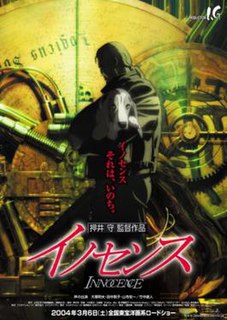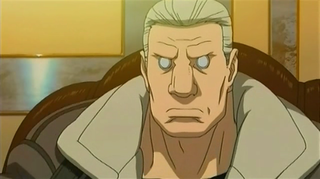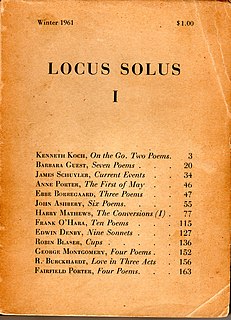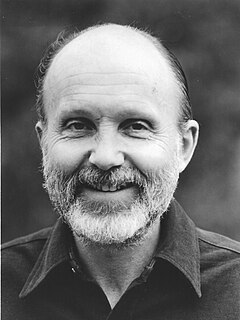
John Lawrence Ashbery was an American poet and art critic.

Amerika, also known as The Man Who Disappeared, The Missing Person and as Lost in America, is the incomplete first novel by author Franz Kafka (1883–1924), written between 1911 and 1914 and published posthumously in 1927. The novel originally began as a short story titled "The Stoker". The novel incorporates many details of the experiences of his relatives who had emigrated to the United States. The commonly used title Amerika can be traced to the edition of the text put together by Max Brod, a close friend of Kafka's during the latter's lifetime, after Kafka's death in 1924.
Monty Cantsin is a multiple-use name that anyone can adopt, but has close ties to Neoism. Monty Cantsin was originally conceived as an "open pop star." In a philosophy anticipating that of free software and open source, anyone could perform in his name and thus contribute to and participate in his fame and achievements.

Ghost in the Shell 2: Innocence, known in Japan as just Innocence, is a 2004 Japanese animated cyberpunk film written and directed by Mamoru Oshii. The film serves as a standalone sequel to Oshii's 1995 film Ghost in the Shell and is loosely based on the manga by Masamune Shirow.
The New York School was an informal group of American poets, painters, dancers, and musicians active in the 1950s and 1960s in New York City. They often drew inspiration from surrealism and the contemporary avant-garde art movements, in particular action painting, abstract expressionism, jazz, improvisational theater, experimental music, and the interaction of friends in the New York City art world's vanguard circle.

Peter Ulrich Weiss was a German writer, painter, graphic artist, and experimental filmmaker of adopted Swedish nationality. He is particularly known for his plays Marat/Sade and The Investigation and his novel The Aesthetics of Resistance.

Raymond Roussel was a French poet, novelist, playwright, musician, and chess enthusiast. Through his novels, poems, and plays he exerted a profound influence on certain groups within 20th century French literature, including the Surrealists, Oulipo, and the authors of the nouveau roman.

Harry Mathews was an American writer, the author of various novels, volumes of poetry and short fiction, and essays. Mathews was also a translator of the French language.

Batou is a main male character in Masamune Shirow's Ghost in the Shell series. He is the second-best melee fighter in Section 9, and is the second in command under Major Motoko Kusanagi. He is a battle-hardened cyborg special operative with a long distinguished military career and a no-nonsense attitude. Though he looks imposing, he is known for his warm heart, sense of humor, and love for animals.
Ian Monk is a British writer and translator, based in Paris, France.
Ann Quin was a British writer noted for her experimental style. The author of Berg (1964), Three (1966), Passages (1969) and Tripticks (1972), she killed herself in 1973 at the age of 37.

Locus Solus was an American journal of experimental poetry and prose that published four issues in 1961 and 1962, one (III-IV) a double issue. The magazine was edited by the writer Harry Mathews and the poets John Ashbery, Kenneth Koch, and James Schuyler, all of whom contributed to its four issues. The content was completely in English but the journal was published in France by Mathews.

The Hypothesis of the Stolen Painting is a 1978 French experimental mystery film directed by Chilean filmmaker Raúl Ruiz and shot by cinematographer Sacha Vierny. The film was inspired by the themes of French writer Pierre Klossowski and makes references to many of Klossowski's works including The Revocation of the Edict of Nantes, The Baphomet and “La Judith de Frédérique Tonnerre.” Ruiz was originally commissioned by a French TV network to make an arts documentary on Klossowski, but what emerged is this film, a parody of the art documentary. The film was featured in film festivals after its release such as the London Film Festival in 1979. Hypothesis of the Stolen Painting has been noted as one of Ruiz's masterpieces that challenges the boundaries of cinema and film theory.

Francisco Tropa is a Portuguese sculptor and visual artist. He lives and works in Lisbon.
La statue retrouvée is a short composition for organ and trumpet by Erik Satie. Commissioned as a danced pièce d'occasion, it was originally set to a scenario by Jean Cocteau and featured choreography by Léonide Massine and costumes designed by Pablo Picasso. Its only performance in this form took place in Paris on May 30, 1923.
Mark Amerika is an American artist, theorist, novelist and professor of Art and Art History at the University of Colorado. He is a graduate of the Literary Arts program at Brown University, where he received his MFA in creative writing in 1997.

Kenneth Gangemi is an American poet and fiction writer, best known for his 1969 debut novel, Olt, which has been variously republished and translated.
Sozita Goudouna (Greek: Σωζήτα Γκουντούνα is a curator, professor and the author of Beckett's Breath: Anti-theatricality and the Visual Arts on Samuel Beckett's Breath, one of the shortest plays ever written for the theatre, published by Edinburgh University Press and released in the US by Oxford University Press. According to William Hutchings' review at the Comparative Drama Conference Series 15, Goudouna's book is surely the most ever said about the least in the entire history of literary criticism.

La Passion selon Sade is an opera by Sylvano Bussotti who also wrote the libretto, and was the set designer and director. The subtitle is "mistero da camera", describing it as a chamber mystery play. It was Bussotti's first work for the stage. The opera premiered in 1965 in Palermo with soprano Cathy Berberian, who portrayed two characters from novels by the Marquis de Sade, Justine and Juliette. It has been regarded as experimental musical theatre in several respects.












